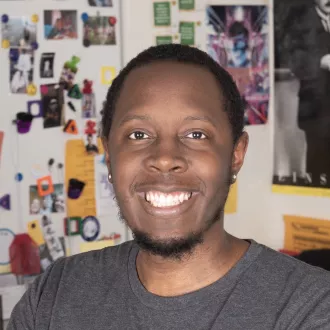Key Takeaways
- Bullying prevention must start early.
- Students see how social media is used for discord and use similar language in how they bully each other, often without realizing how offensive and hurtful the language can be.
- Building trust with students allows them to talk more openly about what they are seeing occur between classmates.
Bullying is on the rise. But not in the way you might think.
Brandon Thornton, a teacher at Bloomington High School in Illinois, says he doesn’t see bullying play out in his classroom the way it's most often presented in the media. Long gone are the days of the “1980s type of bully who wakes up every day and decides to steal someone’s lunch money,” he says.
Now bullying is more verbal, and the attacks occur at school and online.
However, the primary concern for Thornton is that the line between merely joking and bullying has become even more blurred. “Students might say something that we as adults deem harmful, but as kids, they think it's playful banter. But it's not for the kid on the receiving end.”
As the rates for bullying increase across the country, kids are taking cues from social media to be more offensive to one another. They are continuing to find new ways to bully both inside and outside of the classroom. Most often, kids are not defending one another in instances of bullying. With a focus on ways to prevent bullying, educators look to social-emotional learning to build kids' social awareness and emotional intelligence.
Polarization During Pandemic
The recent lack of social awareness can be traced to the pandemic. Thornton cites a shift in how students communicated with each other after returning from pandemic closures. In a world ever more driven by social media, naturally, kids began mirroring communication that they saw on social platforms, which was derisive and damaging during the height of COVID-19.
“They talk [to each other] the way they text and write comments or the way they see them online. And we, as adults, know how social media comments often reflect the worst part of society.”
Most student bullying occurs online and outside of school hours, many times through the growing prevalence of “finstas,” which are fake Instagrams.
Finstas are secondary Instagram profiles that kids use to share with a select group of followers. In most cases, little information exists to help identify the account’s owner. The secrecy of these accounts allows bullies to make fun of other kids without fear of consequences.
This challenges parents and teachers to stay updated on what kids do online. Thornton suggests parents “take an active role” in what their kids are doing on their phones. Because, even if bullying is happening at school, he says, “the child is going to be texting someone about it.”
Quote byBrandon Thornton , High school teacher

What Comes Next?
Illinois recently implemented a policy that requires teachers to notify parents 24 hours after their child is involved in bullying. While the change will not go into effect until next school year, Thornton is hopeful about its success.
“I think it lights a fire under both the school and the parents to resolve this,” he says.
Prevention and intervention strategies are important because bullying continues to be a persistent issue worrying educators.
A RAND Corporation study found that bullying was among teachers’ top school safety concerns, as well as student fights and school shootings. The study occurred in the fall of 2022, shortly after the Robb Elementary School Shooting in Uvalde, Texas.
Researcher Pauline Moore says that “school shootings are extreme forms of violence that are absolutely horrible.” However, they are also “rare events relative to bullying which teachers and school staff probably see on a daily basis.”
For educators looking into ways to prevent the daily occurrence of bullying, fostering positive school climates can be helpful. “Studies show that positive school climates are correlated to making students feel safer,” researcher Heather Schwartz says.
Preventative Measures: Social Emotional Learning
Beyond the physical, an emotional aspect of school safety exists. Feeling safe to express feelings to teachers and other adults is vital to preventing bullying. Many schools now focus on such preventative measures, instructing students to process their emotions in social situations.
District 87 of Bloomington, Illinois, and the same district Thornton teaches in, recently adopted a new social-emotional learning curriculum, which began this school year.
It covers students from kindergarten through 12th grade. There are “7 Mindsets” of the curriculum that encourage students to foster positive school environments rooted in their interactions with one another.
This approach, Thornton describes, has been instrumental in the students' understanding of what it means to be emotionally intelligent.
“A lot of kids are hearing that their peers are suffering from something that they probably didn’t think was harmful,” he says.
Along with their self-reflection, students learn more about what it means to be a bystander. Thornton describes the bystander effect, which discourages students from intervening in instances of bullying for fear of becoming a target, as a significant part of the problem.
“I’ve never had a student stand up and say, ‘Hey, this person’s getting bullied.’ It’s always the victim coming forward.”
By helping students understand what constitutes bullying and how they can help prevent it, teachers can play a critical role in addressing the problem and helping more students come forward.
Other measures in Illinois, like the Senate 100 Bill, which eliminated “zero-tolerance” policies, effectively make it more difficult for schools to suspend students. Thornton feels they will aid in bullying prevention as well.
More positive practices to help students rather than just punish them are the “perfect recipe for repairing that harm with the support of a parent rather than overly suspending kids for something that they didn’t understand was wrong,” he says.
These new policies encourage teachers, schools, and the district to work together to combat these issues. However, for teachers like Thornton, students also need to be part of the larger conversation.
“We have policies, but we never asked kids, ‘What do y’all want to do?’” Thornton says.
As the voices of educators, legislators, and researchers join together to combat bullying, the consensus remains that the voices of students are vital to continuing the mission of creating safer schools for all students.


